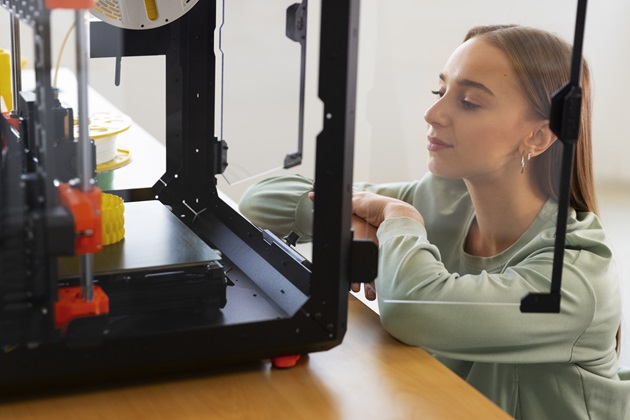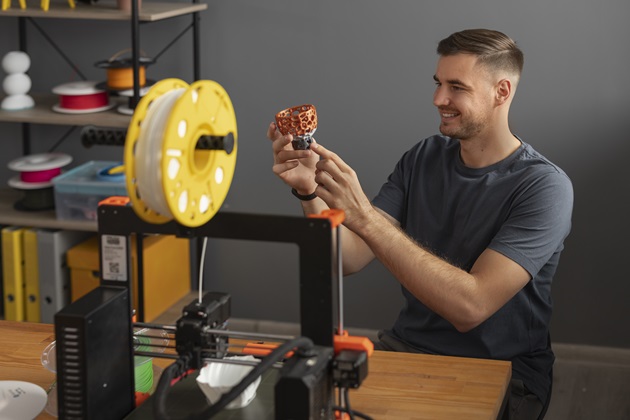Discover 5 3D Printing Filaments You Can Use
3D printing is one of those technologies that sounded like science fiction in the past but is increasingly found in homes, schools and businesses nowadays. Prototyping, model-making or creating functional items are activities where the kind of filament you use can be the difference between success and failure. Each material has its strengths, weaknesses and optimal uses. Being aware of what filament is suitable for your project means you are making the most out of your printer and preventing the frustration of waste materials and time.
ABS

Let’s start with one of the most popular ones. For a good 3D printer ABS filament is one of the most widely used materials and for a very good reason. It’s a rugged, durable plastic that has been a favourite among manufacturers for years. ABS even happens to be the same plastic Lego bricks, car parts, and most consumer goods are constructed of, so you can rest assured it’s not disappearing anytime soon.
Is ABS filament good for 3D printing? One of the main strengths of ABS is its durability. Compared to other filaments like PLA, it can withstand higher temperatures and handle more impact, making it a great choice for parts that need to be functional rather than just decorative. If you’re printing mechanical components, tools, or even prototypes that need to be tested under stress, ABS is a reliable option. Its longevity means you will fret less over breakage or tears in everyday usage.
Another feature that separates ABS is how flexible it is. Not as flexible as material like TPU, but more than PLA, which tends to be somewhat brittle. This strength with slight give is ideal for situations where the part needs to take stress and a little bit of movement.
Even with this, printing with ABS is not always straightforward. It must be printed on a warm bed, or else it will warp, and it will emit very strong fumes while being printed. For this reason, good ventilation or even an enclosed printer is highly recommended. These additional considerations do make it a bit more challenging for new users to handle, but after you are accustomed to it, the reward is worth it.
One of the biggest benefits of ABS is that it is very easily post-processed. It can be sanded, drilled into, or even acetone vapour smoothed to achieve a glossy professional look. This is the reason it is a top choice for projects where function and aesthetics are both equally important.
PLA
Polylactic Acid, or PLA, is typically the first filament that beginners work with. It’s made from renewable resources like corn starch or sugarcane and is therefore greener than petroleum-based plastics. PLA is a favourite as it’s easy to work with, has a lower print temperature and less warping, and is best suited for beginners.
The prints have a smooth surface and bright colours and need a minimal heated bed. PLA, however, is not as strong as ABS and is not resistant to heat. Place a PLA object in a parked vehicle, and it can melt or warp. Use it for decorations, prototypes, or models that do not need to endure rough use.
PETG
Polyethylene Terephthalate Glycol, or PETG, is balanced as far as strength and printability. It’s more durable than PLA but easier to handle than ABS. PETG is water- and chemically-resistant, which makes it a great option for items like water containers, food containers, or exterior applications.
It warps less than ABS, is glossy in finish, and is relatively odourless. PETG can be stringy to print with, so you may need to adjust your settings. If you need strength, toughness and simplicity of printing, PETG is an excellent compromise.
Nylon
Nylon also has excellent strength and flexibility. If you require parts that will bend but not break, nylon is the solution. It’s durable enough for use in functional parts such as gears, hinges, or tool handles. Nylon also wears well and can resist abrasion better than a lot of other filaments.
ASA
Acrylonitrile Styrene Acrylate, or ASA, is just what it sounds like — a better-grade form of ABS. It is just as tough and durable, but has added weather resistance. ASA is especially appropriate for outdoor applications since it resists UV light without breaking down or fading. That makes it particularly appropriate for garden equipment, exterior fixtures or auto parts.
How to Choose the Right Ones

Choosing the right filament depends on your project. When you are a beginner or doing decorative models, PLA is a worry-free option. For durable parts that can handle heat, ABS or ASA are the best bets. PETG gives you a combination of strength and easy printing, and nylon is perfect for parts that need strength and flexibility. Think about where your print will be put to use, how stressed out it will be, and what finish you prefer. Sometimes it takes a bit of experimentation to find your perfect match, but that is part of the fun of 3D printing.
3D printing opens up a world of possibilities, but the filament you choose can make or destroy your project. For a 3D printer, from ABS filament to user-friendly PLA, each offers its own advantages. Having an understanding of what each does best means you can pick the right one for your project and make your designs with confidence.